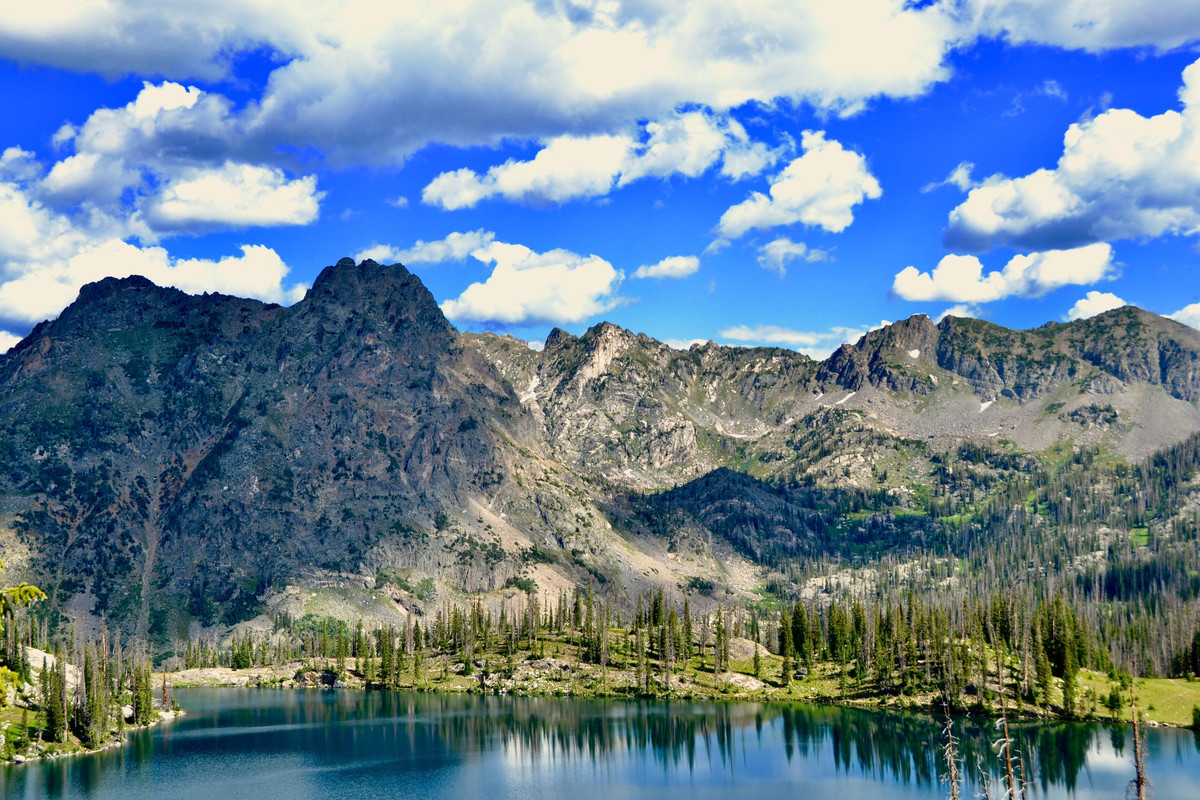- My Forums
- Tiger Rant
- LSU Recruiting
- SEC Rant
- Saints Talk
- Pelicans Talk
- More Sports Board
- Fantasy Sports
- Golf Board
- Soccer Board
- O-T Lounge
- Tech Board
- Home/Garden Board
- Outdoor Board
- Health/Fitness Board
- Movie/TV Board
- Book Board
- Music Board
- Political Talk
- Money Talk
- Fark Board
- Gaming Board
- Travel Board
- Food/Drink Board
- Ticket Exchange
- TD Help Board
Customize My Forums- View All Forums
- Show Left Links
- Topic Sort Options
- Trending Topics
- Recent Topics
- Active Topics
Started By
Message
Plants in a wet/swampy area of yard
Posted on 3/28/20 at 9:35 am
Posted on 3/28/20 at 9:35 am
What plants have successfully flourished for you in wet areas of your yards? I am thinking of doing some hardy hibiscus to get some good coverage and help with the wet spots for mowing.
This post was edited on 3/28/20 at 10:06 am
Posted on 3/28/20 at 9:39 am to USEyourCURDS
I've just been researching the same thing.
I'm digging a french drain to flow into a low spot.
From the Houston Chronicle:
Just bought a beauty berry. I like the purple.
Also on my radar are: Lamb's ear (pretty cool plant), bee balm, black eyed susan, Turk's cap, and Mexican Petunia.
I'm digging a french drain to flow into a low spot.
From the Houston Chronicle:
quote:
For your rain garden
Flowering plants: Turk's cap, Mexican petunia (ruellia), black-eyed Susan, yarrow, swamp milkweed, butterfly weed, canna, purple coneflower, daylily, spider lily, swamp ginger, Mexican mint marigold, lamb's ear, bee balm, 'Red Star' hibiscus, and a few varieties of iris including Louisiana and bearded
Shrubs and small trees: American beauty berry, yaupon, dwarf palmetto, possumhaw holly and Southern wax myrtle
Big trees: Southern swamp maple, river birch, bald cypress, pawpaw, and various native hawthorns.
Other plants: Many ornamental and native grasses do well in rain gardens, such as switchgrass, Indian grass and sedge. crossvine and Carolina jessamine work in both wet and dry conditions.
Just bought a beauty berry. I like the purple.
Also on my radar are: Lamb's ear (pretty cool plant), bee balm, black eyed susan, Turk's cap, and Mexican Petunia.
This post was edited on 3/28/20 at 9:41 am
Posted on 3/28/20 at 9:58 am to USEyourCURDS
iris
spider lily
wax myrtle
willow
palmetto
go have a walk thru a wet woodsy area and see what grows there. Then plant those
spider lily
wax myrtle
willow
palmetto
go have a walk thru a wet woodsy area and see what grows there. Then plant those
Posted on 3/28/20 at 10:08 am to cgrand
Might do a mixture of flowering shrubs. I like the added benefit of privacy when they get big enough. It is a large area of my property line so something that grows 4ft or so outward would be great.
Posted on 3/28/20 at 11:16 am to USEyourCURDS
I didn’t realize Turks Cap was a wetland plant but I see it’s in the mallow family with hardy hibiscus so makes sense. I’ve have about a dozen in my landscape. Grows well and flowers in both sun and relatively heavy shade - in fact I planted them in heavy shade as it is one of the limited number of flowering shrubs that do well in heavy shade. Attracts hummingbirds. Grows to the size you are looking for pretty quickly. Though not evergreen per se I’ve found that it pretty much holds it leaves year around in Baton Rouge except exceedlingly hard and lengthy freezes.
I also like American Beautyberry (“French Mulberry”). Parsley Hawthorne is nice small wetland tree - but be aware all the hawthornes are thorny as reflected in their name. Button bush is another woody shrub you might look into. I don’t have any, but I know it grows well in wetland conditions.
I also like American Beautyberry (“French Mulberry”). Parsley Hawthorne is nice small wetland tree - but be aware all the hawthornes are thorny as reflected in their name. Button bush is another woody shrub you might look into. I don’t have any, but I know it grows well in wetland conditions.
Posted on 3/28/20 at 12:02 pm to CrawDude
Did you graduate in horticulture?
Posted on 3/28/20 at 12:38 pm to bayoubengals88
Cliftonia monophylla,
walters viburnum Viburnum obovatum
Ilex glabra Gallberry Inkberry
Lyonia lucida Fetterbush
Myrica heterophylla Swamp Bayberry
aster vine
all natives
walters viburnum Viburnum obovatum
Ilex glabra Gallberry Inkberry
Lyonia lucida Fetterbush
Myrica heterophylla Swamp Bayberry
aster vine
all natives
This post was edited on 3/28/20 at 12:39 pm
Posted on 3/28/20 at 12:43 pm to bayoubengals88
quote:
Did you graduate in horticulture?
Posted on 3/28/20 at 12:55 pm to CrawDude
What did yall do to remove grass while getting these areas filled in? And how did yall keep it from running back into these areas?
Posted on 3/28/20 at 1:58 pm to lsurulzes88
quote:
What did yall do to remove grass while getting these areas filled in? And how did yall keep it from running back into these areas?
Do you mean filled in with plants? I have a few low areas in the yard, I do get some runoff from neighbors, and I’ve installed drainage and graded to greatly improve the problem but still contend with some wet areas.
In those areas rather than spend a lot of time and effort with adding additional underground drainage I sprayed the grass with glyphosate herbicide but I did not remove the grass. I bought in bulk garden soil/mix, built raised landscape beds (about 12 inches high, it settles about 1/3 over time) directly over the grass I sprayed, and planted “wetland” shrubs in those “wet area” beds. Examples of plants in those beds are American Beautyberry, Henry Garnet Virginia Willow (sweetspire). It has worked fine - no issue associated with not removing the dead grass and saved me a ton of work, plants are doing very good. I might add I have a 26 year old bald cypress in that area and I’m sure it does it’s share of work in helping to remove excess water during heavy or extended rain events.
No magic bullet for keeping grass from running back into beds. I don’t use physical barrier edging, not my cup of tea, but no issue with those that do. I keep it suppressed by “weed eating” along the beds but 2 or 3 couple times a year I physically remove grass runners into those beds. Less work if you keep up with it before it gets out of hand.
I don’t know if that addressed the questions you are asking.
This post was edited on 3/28/20 at 2:39 pm
Posted on 3/28/20 at 2:11 pm to CrawDude
Just wondering. You’re all over this board 
Am I on a fool’s errand here? Or does this have potential??
My house was storing water badly to the left of the AC unit. The slope was just all wrong.
Now, I’ve dug quite the trench to the lowest spot in my yard. Holds a few inches of water.
I want to make this a creek feeding a rain garden.
Could it work?

Am I on a fool’s errand here? Or does this have potential??
My house was storing water badly to the left of the AC unit. The slope was just all wrong.
Now, I’ve dug quite the trench to the lowest spot in my yard. Holds a few inches of water.
I want to make this a creek feeding a rain garden.
Could it work?

This post was edited on 3/28/20 at 2:12 pm
Posted on 3/28/20 at 2:16 pm to bayoubengals88
Try using this to convey the water away from the house. LINK to hydraway
Posted on 3/28/20 at 2:36 pm to eng08
a description of natives to the gulf south in wet areas:
Overstory species in the habitat may include Atlantic white cedar (Chamaecyparis thyoides), sweet bay (Magnolia virginiana), red bay (Persea borbonia), loblolly bay (Gordonia lasianthus), tupelo (Nyssa spp.) and pines (Pinus spp.). It shares the understory with other plants such as sweetbells (Eubotrys racemosa), highbush blueberry (Vaccinium corymbosum), sweet pepperbush (Clethera alnifolia), titi (Cyrilla racemiflora), laurelleaf greenbrier (Smilax laurifolia), honeycup (Zenobia pulverulenta), and oaks (Quercus spp.)
Overstory species in the habitat may include Atlantic white cedar (Chamaecyparis thyoides), sweet bay (Magnolia virginiana), red bay (Persea borbonia), loblolly bay (Gordonia lasianthus), tupelo (Nyssa spp.) and pines (Pinus spp.). It shares the understory with other plants such as sweetbells (Eubotrys racemosa), highbush blueberry (Vaccinium corymbosum), sweet pepperbush (Clethera alnifolia), titi (Cyrilla racemiflora), laurelleaf greenbrier (Smilax laurifolia), honeycup (Zenobia pulverulenta), and oaks (Quercus spp.)
Posted on 3/28/20 at 3:41 pm to bayoubengals88
quote:
Just wondering. You’re all over this board
I used to do university extension work in the aquatic area at one time, so it’s like the old days when I was answering pond owner questions on a daily basis, but the H&G board is more challenging.
quote:
Am I on a fool’s errand here? Or does this have potential??
My house was storing water badly to the left of the AC unit. The slope was just all wrong.
Now, I’ve dug quite the trench to the lowest spot in my yard. Holds a few inches of water.
I want to make this a creek feeding a rain garden.
Could it work?
Sure it will work if you have sloped properly to the rain garden, I’m impressed - that’s a lot of work, must have been a bear digging through tree roots - you have 2 big ones there. I have a good friend whose neighbor across the street did something similar to move water to the street, they have lined with rocks for aesthetics looks nice and very functional.
Now another option, which I’ve done my self, should you find you don’t like the trench down the road, is to put a sump pump basin and pump at the low area next to the house where all the water collects, then put a 1.5 or 2 inch discharge pipe in your trench, back fill and place a popup emitter at the end of the pipe that discharges into rain garden you plan to build. You have electrical close by you can tie into. A pump of the size you would require runs on 120 V, and 15 amp circuit breaker, though 20 amp is better. Here are a few pics of mine that pumps water from the backyard, down the side of the house to the front yard.
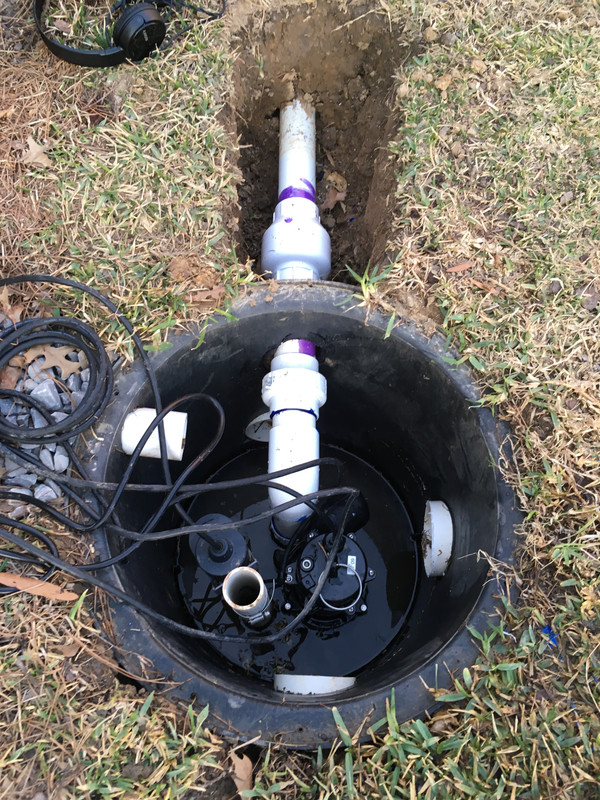
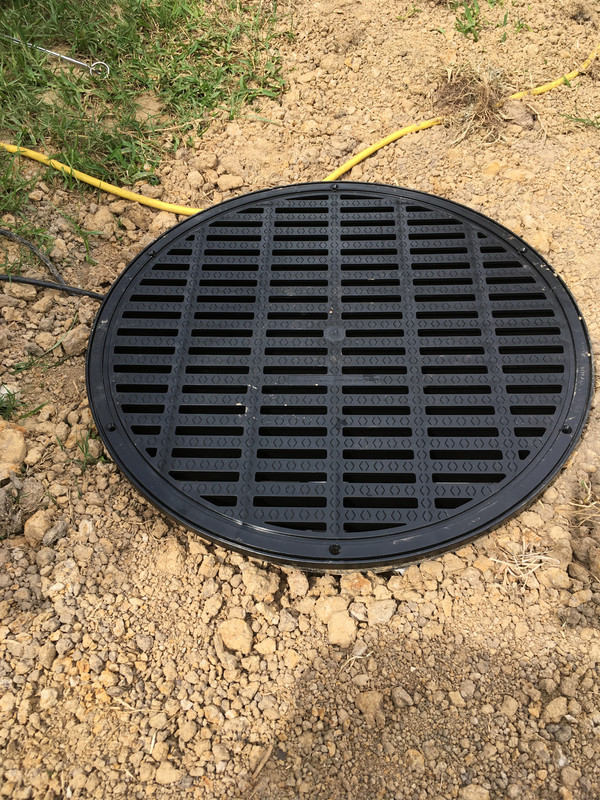
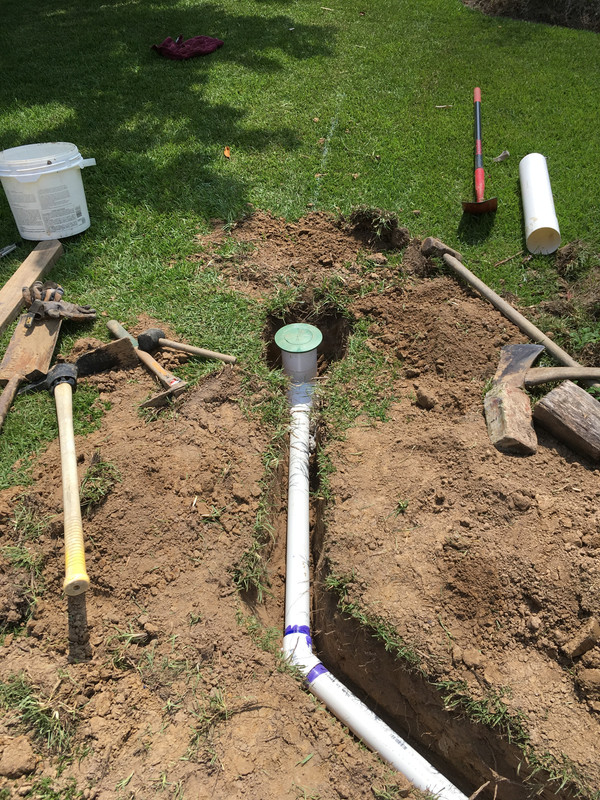
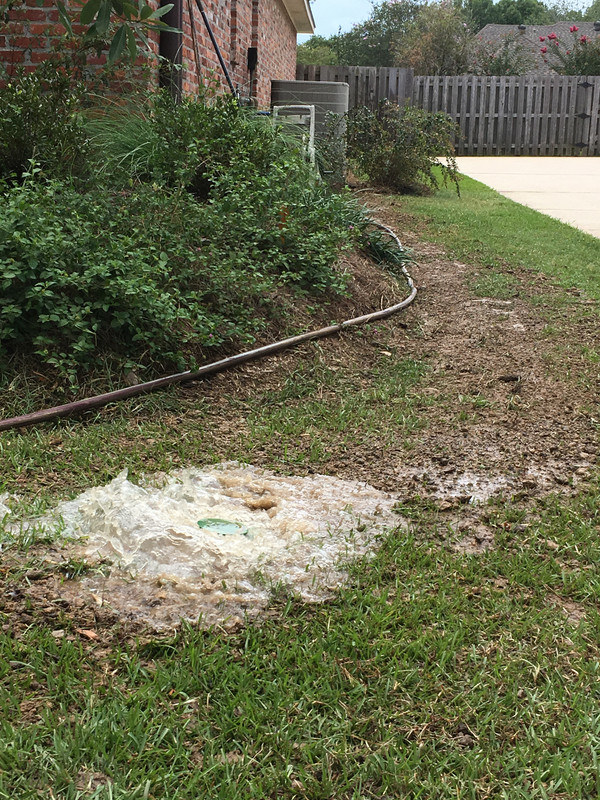
This post was edited on 3/28/20 at 4:58 pm
Posted on 3/28/20 at 4:16 pm to CrawDude
Snakes will love this option.
Posted on 3/28/20 at 7:13 pm to bayoubengals88
quote:
Shrubs and small trees: American beauty berry, yaupon, dwarf palmetto, possumhaw holly and Southern wax myrtle
Sheesh, maybe on the edge, but not in the middle of a wet area. Beautyberry is most commonly found in upland areas in Louisiana. It's very similar to loblolly pine in that you will find it on the edges of swamps, but it's not a wetland species by any means.
The rest of their list is pretty spot on. I would definitely recommend Texas Star Hibiscus. Beautiful plant, makes big red flowers. Surprised that list didn't include buttonbush. Great wetland plant, very striking white flowers, and great for pollinators. Stay away from switchgrass unless you want it to take over. Copper iris is another great plant with a striking flower. In my opinion, nothing says spring like that beautiful copper flower atop that bright green foliage.
Posted on 3/28/20 at 7:47 pm to USEyourCURDS
Elephant ears, irises, ferns
Popular
Back to top


 4
4

